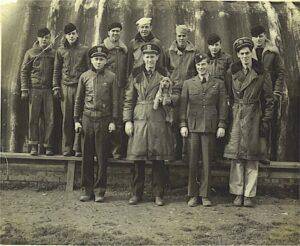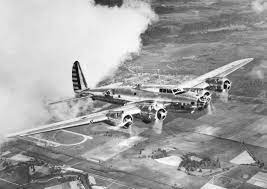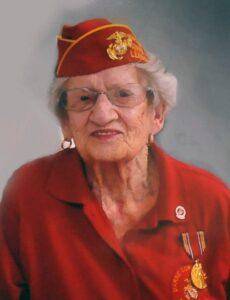Veteran Spotlight – Theodore Felix Ulinski Sr., USN
This Veteran Spotlight column is a regular feature about our Caucus members. We are honoring World War II Veteran, Theodore Felix Ulinski, Sr., for his service to our nation in uniform for 37 years in the U.S. Navy on active duty and in the reserve. Article submitted by his daughter, Deborah Potter, Caucus Military Family Member.

Theodore Felix Ulinski, Sr., father of Deborah Potter (SCC / Ward 15A, Chair Pct. 220 and member of the American Legion Post 69 Auxiliary), served for a total of 37 years in the US Navy.
That included during World War II and inactive reserve. After attending Pittsburgh Institute of Aeronautics, he became a government-licensed aviation mechanic. During World War II he was the In-Flight Mechanic of the B24, the Liberator.
He flew with pilot Joseph Kennedy, Jr., U.S. Navy anti-submarine warfare squadron VPB-110. However, Ulinski declined the dangerous volunteer mission Operation Aphrodite that took the life of Kennedy and his Co-Pilot. The mission involved flying a drone bomber plane with 21,170 pounds of explosives and parachuting out after giving radio control to an aircraft that was following behind. Unfortunately, the bombs exploded prematurely over England, taking the life of the pilot and co-pilot.

View actual film footage of Operation Aphrodite, the mission that killed Joseph Kennedy, Jr., HERE.
Our Personal Experience at Margraten
by Richard Moody, Military Family Member and Caucus CD 1 Vice Chair
Memorial Day Commemoration in the Netherlands
In the small town of Margraten in the Netherlands lies an American Battle Monuments Commission (ABMC) cemetery, the Netherlands American Cemetery and Memorial. It is the only U.S. military cemetery in the Netherlands, but that is not what makes it unique.
Located just east of Maastricht, near the Dutch-German border, the sixty-five-acre cemetery holds the remains of 8,301 American service men and women. Since the first American soldier was laid to rest there on 10 November 1944, the local Dutch citizens have taken special care of the graves, and have taken a special interest in the soldiers and airmen buried there.

After five long years of Nazi occupation during WWII, the Dutch welcomed Allied liberators with open arms. The last few months of the war were especially brutal in terms of casualties, as Germany tried desperately to stave off defeat. Between late 1944 and the end of the war, up to 500 bodies a day arrived in Margraten for burial. The town’s mayor went door to door asking for Dutch volunteers to help the U.S. Army’s 611th Quartermaster Graves Registration Company dig graves for the fallen Americans.
Shortly after the war’s end, the Margraten town clerk and a local pastor came up with the idea of an adoption program: local Dutch individuals and families could volunteer to help care for the graves. The ABMC oversees and maintains the graves and the cemetery, cutting the grass, weeding, and cleaning the white marble crosses and Stars of David. The Dutch ‘adopters’ stop by several times a year and place flowers on a particular serviceman’s graves – usually on the soldier or airman’s birthday, on the date they died, at Christmas, and on Memorial Day.
There are two ABMC cemeteries in Belgium that have a similar adoption program, but Margraten’s is different: there is the only one where every grave has a volunteer caretaker, and there is a waiting list of more than one hundred people who wish to be caretakers. Over the years, Belgian and German volunteers have joined the Dutch caretakers at Margraten.
A large number of the Dutch caretakers pass on what they consider to be an honor and a sacred duty to their children, and to their children’s children. Some of the Dutch families are on their fourth generation of caretakers, each generation instilling the tradition in the one that follows.
In 1998, my wife, Claudia Risner, and I were working at the American Embassy in The Hague. We had the honor of accompanying the U.S. Ambassador to the cemetery in Margraten for Memorial Day. As we stood with the other U.S. military and family members, I was struck by the solemness of the occasion and the reverence shown by the Dutch participants.
Talking with several of the Dutch after the official ceremony, I met two who were caretakers, third-generation caretakers. They told Claudia and me of their families’ tradition of caring for graves of American servicemen of the Greatest Generation, who gave their lives on foreign soil to secure the freedom of people they never met and never knew.
As I have every Memorial Day since 1998, I reflect back on the day Claudia and I spent in the company of Dutch men and women who honor Americans that, in the immortal words of President Abraham Lincoln, gave “the last full measure of devotion” to the country they served and loved. God bless them and their families, and God bless America – the Land of the Free because of the Brave.
Richard Moody
CD 1 Vice Chair

Dorothy “Dot” Cole, who enlisted as one of the earliest female Marine reservists in response to the 1941 bombing of Pearl Harbor and was widely celebrated around her birthday in September as the country’s oldest living Marine, died of a heart attack last Thursday at her daughter’s home in Kannapolis. She was 107.
Her death was confirmed by her only child, Beth Kluttz, 67, who had moved her mother into her home almost 20 years ago. Cole (who at the time was still named Dorothy Schmidt, having not yet been married) was 28 years old when she boarded a bus in her hometown of Warren, Pennsylvania, for the 150-mile trip to Pittsburgh, where she hoped to volunteer for the Navy.
When she tried to enlist, however, the recruiter informed her that, at just 4 feet, 11 inches, she wasn’t tall enough to meet Navy standards. Kluttz, in fact, says her mother’s longtime nickname was “Half-Pint.” So she eventually came up with another plan after returning to Warren: She would learn to become a pilot, and persuade the Marine Corps to let her fly an airplane. It was the longest of long shots. From 1918 to 1942, enlisted female Marines had only been allowed to perform clerical duties. But in July 1942, with the conflict overseas intensifying, President Franklin D. Roosevelt signed the Marine Corps Women’s Reserve into law, to fill the gaps — left by men headed to combat — in administrative, training and supply positions at its bases.
The Corps delayed formation of the branch until February 1943; Cole enlisted five months later, on July 12, 1943, at 29 years old, becoming one of the earliest volunteers for the branch. By that point, she had logged about 200 hours in the cockpit of a Piper Cub and earned her private pilot’s license. It would not be enough to sway the Marines, though. After Cole completed the six weeks of boot camp with the Women’s Reserve’s First Battalion on the beaches of Camp Lejeune near Jacksonville, North Carolina, “They put me behind a typewriter instead of an airplane,” Cole told the Independent Tribune of Concord during an interview pegged to her 107th birthday last September.
Still, “I loved the hats we were wearing,” Cole told the Marine Corps Times, also in September. “It was fun when I got the first complete Marine outfit. I loved it very much and felt right at home with it.” Cole went on to spend her two years of service stationed at a firing range in Quantico, Virginia, with the majority of her responsibilities centering around typing up correspondence for officers. “It was kind of a tough time and we were not welcomed too well by many of the men in the service,” Cole recalled in the Marine Corps Times interview. “But they got over it.”
FROM EAST COAST TO WEST, AND BACK
Cole was born on Sept. 19, 1913, in Warren, a small city near the border of New York state that sits on the banks of the Allegheny River. Hers was an active childhood. In addition to frequenting the Kalbfus Rod & Gun Club in the neighboring borough of Clarendon with her father and brother, she ran track and played basketball and hockey at Warren High; she graduated from the school in 1932. Prior to enlisting, she had worked as a secretary for the YWCA.
She met her future husband — the much taller (at 6-foot-2) Wiley Cole — in Washington, D.C., while both were in the service. Wiley was in the Navy, and served on the USS Hornet, an aircraft carrier that sailed in both the Pacific Theater and the Solomon Islands campaign during World War II before eventually being torpedoed and sunk in October 1942.
The war ended in 1945, and Dorothy Cole was discharged that December as a sergeant in the Marines. “We all left on a train,” Cole said in her interview with the Independent Tribune, “and many of us ladies were singing.”
After the war, she moved to San Francisco to be with Wiley. They got married, and both were hired at the Ames Research Center (which became a part of NASA in 1958) at Moffett Field in Silicon Valley, he as an aerial photographer and she as a secretary. They had their only child, daughter Beth, in 1953. Two years later, Wiley Cole died of a heart attack. Dorothy never remarried.
Beth Kluttz moved from California to North Carolina in 1976. Cole followed her to the area in about 1979. Kluttz says her mother “was doing really good” into the 100th year of her life, and that up to about 102 or 103, “we could still go to Walmart and I could actually leave her alone and she’d go down her own way. And I can remember having a hard time finding her because she was so short, she was shorter than … the clothes racks. … So I had a hard time locating her and a lot of times it scared me trying to find her,” Kluttz recalls, laughing. Kluttz says her mother’s health finally started to deteriorate after she turned 105.
As for how the family found out Cole was the oldest living Marine? Credit goes to Kluttz. Around the time Cole was 103, Kluttz says she was tracking who the oldest female Marine was according to Google. A couple of years later, she says she was given the impression from some Marines based in Quantico that the answer might be her mom, “but at that point in time they couldn’t ever really prove it.”
“So I just put it out there through them that ‘my mother as of this date is this age, and if anybody else is out there, please step forward’ pretty much is what I did,” Kluttz says. Then “I think some other Marines from the Marine Corps League, when she was getting ready to turn 107, they got in touch with headquarters up by the Pentagon there in Washington, and they were able to do the research, and they said, ‘Not only is she the oldest female Marine, but she is actually the oldest Marine as of September 2020.’”
Cole was awarded lifetime membership in the Marine Corps League Cabarrus Detachment 1175 this past September, and after the Independent Tribune published a story ahead of her birthday and the Marine Corps created a video in her honor, she became a minor celebrity.
Most of the Charlotte TV stations produced stories, but even national outlets — from Fox News and The New York Post to Southern Living magazine — acknowledged her 107th birthday and her “oldest living Marine” status. And in the fall, Cole was able to perform one final act of civic responsibility: casting her ballot in the 2020 election at a drive-in voting location at the Kannapolis Train Depot. Cole had lived through 18 presidents, starting with Woodrow Wilson (and her earliest recollection of a president being Calvin Coolidge); in her first three opportunities to vote for a commander in chief — in 1932, 1936 and 1940 — she voted for Roosevelt.
Asked by the Marine Corps Times in September whether she felt like she and other women she entered the Marines with had played a role in shaping history or influencing current female Marines, Cole responded, simply: “I suppose.” It certainly has taken a long time, and it’s been a slow evolution. The Corps didn’t wind up letting a woman fly a Marine aircraft until 1995.
In 2016, it finally opened ground combat jobs to women, and since then, enlisted female Marines have broken through several barriers: According to Military.com, in 2019, a woman became the first-ever female force reconnaissance Marine, and another was the first to complete the brutal second phase of Marine Corps Forces Special Operations Command’s assessment and selection course.
Today, about 9% of the 185,000 Marines in the Corps are women. It is the lowest percentage of any military branch. But it looked like progress to Cole. “I thought that it would impress the Marine Corps, but it didn’t,” Cole told the Marine Corps Times in September about all the flying she did. But “I just landed on my old typewriter. “The girls now, they have an open field with what they can do,” she said, “so it’s gotten better. ”Besides her daughter Beth, Cole is survived by two grandchildren and six great-grandchildren.